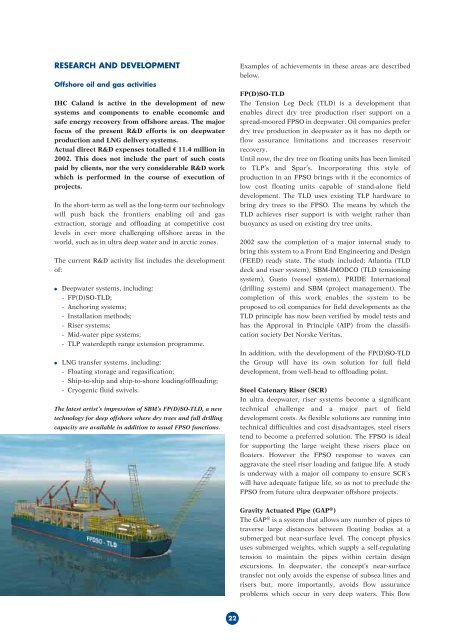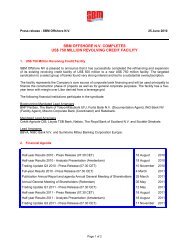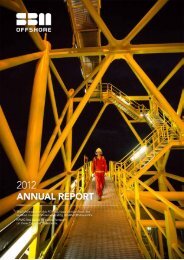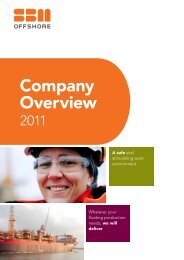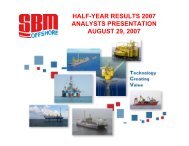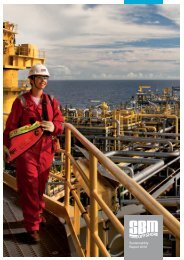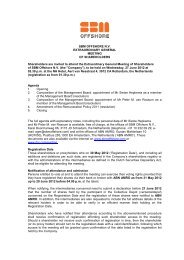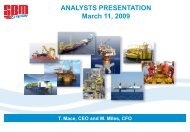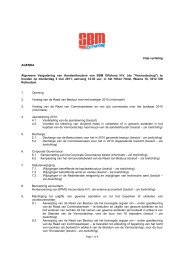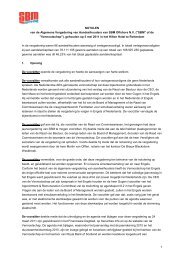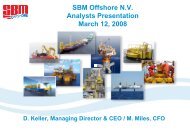2002 Annual Report - SBM Offshore
2002 Annual Report - SBM Offshore
2002 Annual Report - SBM Offshore
You also want an ePaper? Increase the reach of your titles
YUMPU automatically turns print PDFs into web optimized ePapers that Google loves.
RESEARCH AND DEVELOPMENT<br />
<strong>Offshore</strong> oil and gas activities<br />
IHC Caland is active in the development of new<br />
systems and components to enable economic and<br />
safe energy recovery from offshore areas. The major<br />
focus of the present R&D efforts is on deepwater<br />
production and LNG delivery systems.<br />
Actual direct R&D expenses totalled € 11.4 million in<br />
<strong>2002</strong>. This does not include the part of such costs<br />
paid by clients, nor the very considerable R&D work<br />
which is performed in the course of execution of<br />
projects.<br />
In the short-term as well as the long-term our technology<br />
will push back the frontiers enabling oil and gas<br />
extraction, storage and offloading at competitive cost<br />
levels in ever more challenging offshore areas in the<br />
world, such as in ultra deep water and in arctic zones.<br />
The current R&D activity list includes the development<br />
of:<br />
x Deepwater systems, including:<br />
- FP(D)SO-TLD;<br />
- Anchoring systems;<br />
- Installation methods;<br />
- Riser systems;<br />
- Mid-water pipe systems;<br />
- TLP waterdepth range extension programme.<br />
x LNG transfer systems, including:<br />
- Floating storage and regasification;<br />
- Ship-to-ship and ship-to-shore loading/offloading;<br />
- Cryogenic fluid swivels.<br />
The latest artist’s impression of <strong>SBM</strong>’s FP(D)SO-TLD, a new<br />
technology for deep offshore where dry trees and full drilling<br />
capacity are available in addition to usual FPSO functions.<br />
22<br />
Examples of achievements in these areas are described<br />
below.<br />
FP(D)SO-TLD<br />
The Tension Leg Deck (TLD) is a development that<br />
enables direct dry tree production riser support on a<br />
spread-moored FPSO in deepwater. Oil companies prefer<br />
dry tree production in deepwater as it has no depth or<br />
flow assurance limitations and increases reservoir<br />
recovery.<br />
Until now, the dry tree on floating units has been limited<br />
to TLP’s and Spar’s. Incorporating this style of<br />
production in an FPSO brings with it the economics of<br />
low cost floating units capable of stand-alone field<br />
development. The TLD uses existing TLP hardware to<br />
bring dry trees to the FPSO. The means by which the<br />
TLD achieves riser support is with weight rather than<br />
buoyancy as used on existing dry tree units.<br />
<strong>2002</strong> saw the completion of a major internal study to<br />
bring this system to a Front End Engineering and Design<br />
(FEED) ready state. The study included: Atlantia (TLD<br />
deck and riser system), <strong>SBM</strong>-IMODCO (TLD tensioning<br />
system), Gusto (vessel system), PRIDE International<br />
(drilling system) and <strong>SBM</strong> (project management). The<br />
completion of this work enables the system to be<br />
proposed to oil companies for field developments as the<br />
TLD principle has now been verified by model tests and<br />
has the Approval in Principle (AIP) from the classification<br />
society Det Norske Veritas.<br />
In addition, with the development of the FP(D)SO-TLD<br />
the Group will have its own solution for full field<br />
development, from well-head to offloading point.<br />
Steel Catenary Riser (SCR)<br />
In ultra deepwater, riser systems become a significant<br />
technical challenge and a major part of field<br />
development costs. As flexible solutions are running into<br />
technical difficulties and cost disadvantages, steel risers<br />
tend to become a preferred solution. The FPSO is ideal<br />
for supporting the large weight these risers place on<br />
floaters. However the FPSO response to waves can<br />
aggravate the steel riser loading and fatigue life. A study<br />
is underway with a major oil company to ensure SCR’s<br />
will have adequate fatigue life, so as not to preclude the<br />
FPSO from future ultra deepwater offshore projects.<br />
Gravity Actuated Pipe (GAP ® )<br />
The GAP ® is a system that allows any number of pipes to<br />
traverse large distances between floating bodies at a<br />
submerged but near-surface level. The concept physics<br />
uses submerged weights, which supply a self-regulating<br />
tension to maintain the pipes within certain design<br />
excursions. In deepwater, the concept’s near-surface<br />
transfer not only avoids the expense of subsea lines and<br />
risers but, more importantly, avoids flow assurance<br />
problems which occur in very deep waters. This flow


